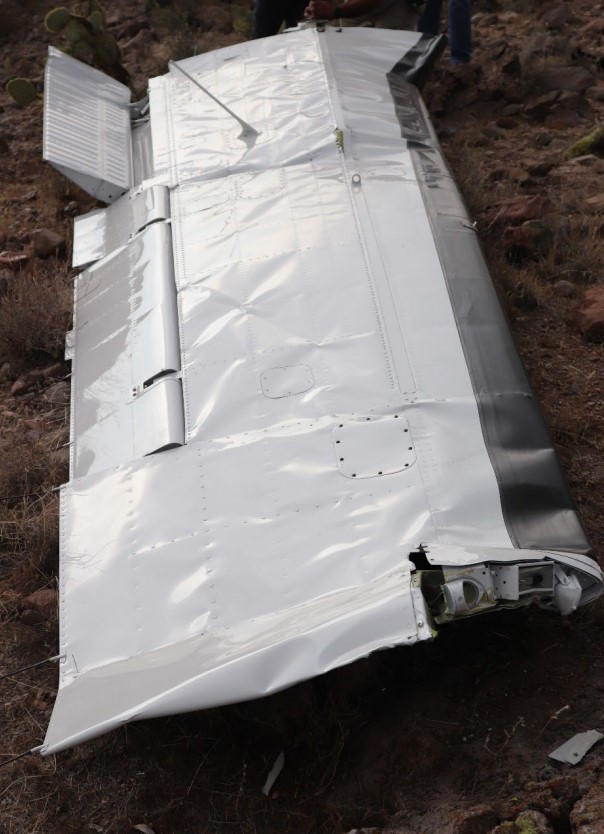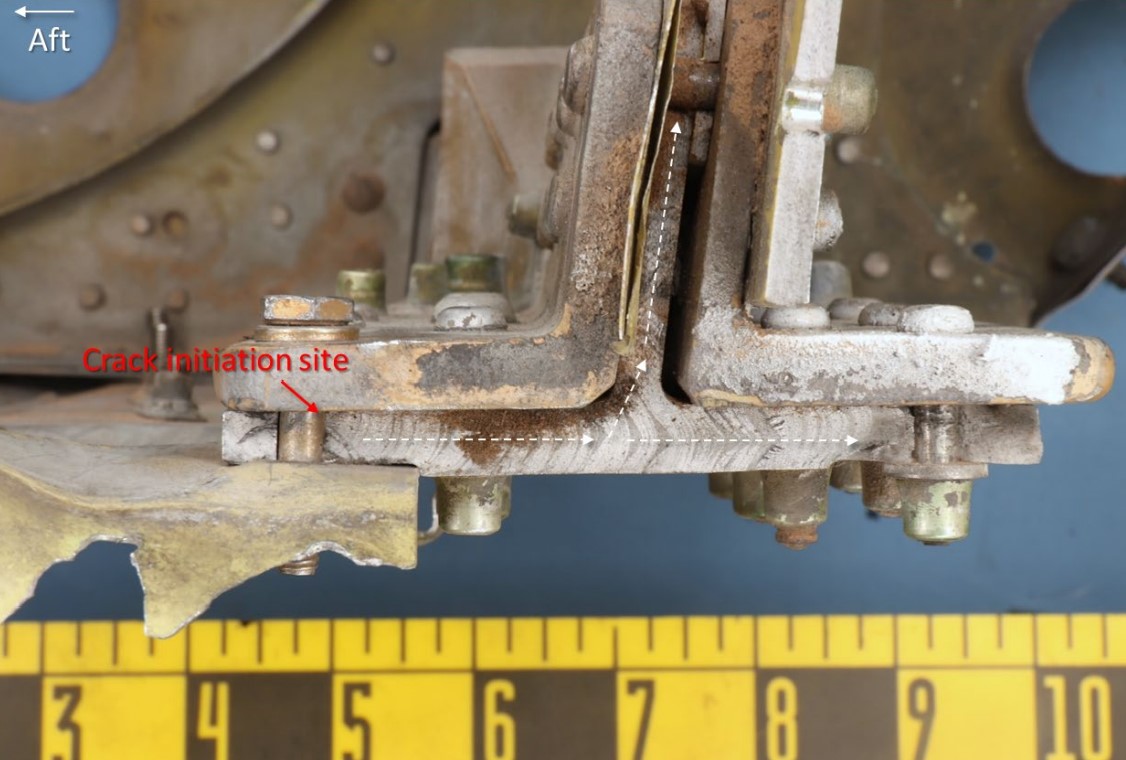In-Flight Break-up of King Air C90 After Wing Spar Repaired Against Manufacturer’s Advice (N3688P, Falcon Executive Aviation)
On 10 July 2021 Beech King Air C90 N3688P broke-up in flight and crashed near Wikieup, Arizona. The aircraft was operated Falcon Executive Aviation in support of firefighting for the Federal Bureau of Land Management (BLM), The pilot and the US Forest Service (USFS) Air Tactical Group Supervisor onboard were fatally injured.
The US National Transportation Safety Board (NTSB) issued their safety investigation report on 23 August 2023.
The Accident Flight
The aircraft was on station for about 45 minutes, completing multiple orbits over the Cedar Basin wildfire. One witness saw the aircraft the descend in a steep dive. No distress call was heard and it impacted mountainous desert terrain. Another witness, a firefighter, observed the outboard left wing falling to the ground shortly after the aircraft had impacted the ground.

Outer Left Wing of USFS / BLM Falcon Executive Aviation Beech King Air C90 N3688P (Credit: NTSB)
The Safety Investigation
Investigators found that:
The main wreckage was mostly consumed by a post-crash fire. Debris was scattered over an area of several acres.

Site of Main Debris from USFS / BLM Falcon Executive Aviation Beech King Air C90 N3688P After Post-Crash Fire (Credit: NTSB)
The outboard left wing was found about 1250 m from the main wreckage. It had separated outboard of the engine nacelle.
The C90 was manufactured in 1980. It had been flown as a aerial supervision / reconnaissance aircraft for firefighting since 2007. This involved operating in orbits at c 1000-3500 ft AGL. It was not used in the more demanding lead aircraft role (low level operation to lead in a larger firefighting aircraft for its drop).
The aircraft had flown 17,262.6 hours and 15,475 cycles at the time of the accident. Since 2007, it had accumulated 3,507 hours and 1,877 cycles.
The NTSB examined the maintenance history of the aircraft. Since 1990, FAA Airworthiness Directive (AD) 89-25-10, Wing Main Spar Inspection had been applicable. This required inspection of “the wing lower forward spar attach fittings, center section, and outboard wing spar caps adjacent to the attach fitting”. It stated:
If any crack is found in a main spar lower cap or fitting, prior to further flight repair or replace the defective part using the instructions and limitations specified in the Beech SIRM or other FAA approved instructions provided by Beech Aircraft Corporation.
On this aircraft…
A total of 16 wing spar inspections were accomplished since the AD became effective and 6 times since the airplane went on contract to the USFS in 2007. Further, the annual spar cap visual inspection for cracks and corrosion [as specified in the Beech Structural Inspection and Repair Manual (SIRM) 57-13-01] was accomplished 16 times since 2007.
However, in March 2021…
During a scheduled [AD 89-25-10 and SIRM 57-13-01] maintenance inspection…eddy current (EC) non-destructive testing (NDT) of a left wing’s lower forward spar cap detected a crack in a fastener hole.
The hole was then oversized/reamed to a larger size, but the EC reinspection still produced a crack indication.
The operator then submitted a structural damage report and service request detailing the crack indication to the aircraft manufacturer.
The manufacturer responded in April 2021 that this necessitated the replacement of “the center section forward spar cap, center section forward lower fittings and both outboard main spar assemblies.”
The email response…to FAS also included the warning below from their published instructions for wing structure inspections in the SIRM 57-13-01, (in part [emphasis in original]):
WARNING: A crack in the center section lower forward spar cap necessitates the replacement of all lower forward inboard fittings, the lower forward spar cap on the center section, and both outboard forward wing panel main spar assemblies.
However, the operator and their maintenance provider [Falcon Air Service (FAS)] elected to repair the wing spar instead….
The maintenance facility owner contacted a FAA Designated Engineering Representative (DER) for the design of the repair.
The repair involved oversizing the affected fastener hole and installing an external doubler around the hole location.
The repair was installed and signed off in May 2021, with an FAA Form 337, Major Repair and Alteration, and included FAA Form 8110-3, Statement of Compliance with Airworthiness Standards, from the DER.
However:
The DER claimed no knowledge of the communication between the aircraft manufacturer and the maintenance provider about the crack indication, though the maintenance provider claimed otherwise.
Afterwards a further EC inspection “showed the wing spar repair to be successful”. The area of the repair was not recovered and so could not be examined by investigators.
A post accident examination of the spar fracture surface revealed that the left wing’s lower spar cap fractured from a fatigue crack that initiated at the aft inboard fastener hole.
This was NOT in the same area as the repair.
The fatigue crack measured 2.484 inches in length and exhibited striations consistent with crack propagation.

Wing Spar Lower Cap Fatigue Crack USFS / BLM Falcon Executive Aviation Beech King Air C90 N3688P (Credit: NTSB)
Significantly:
A study comparing the crack length. striations, flight hours, and number of cycles suggests the crack was large enough to have been seen visually at the last inspection.
This suggests the inspection, was either not conducted or was conducted inadequately. The NTSB confirm the inspector was qualified and completed the 2 day Beech training required by the AD. The NTSB delve no further into the inspection to, for example, identify any human factors that may have influence the inspection.
If the manufacturer’s instructions had been followed, the area that catastrophically failed would also have been replaced. However, NTSB do record that the FAA stated that “had an AMOC [Alternate Method of Compliance] been requested for this repair through the Wichita ACOB, we most likely would have approved it”.
NTSB Probable Cause
The failure and separation of the left wing’s outboard section due to a fatigue crack in the lower spar cap.
Contributing to the accident was the operator’s decision to repair the wing spar instead of replacing it as recommended by the aircraft manufacturer.
Also contributing to the accident was the failure of the Non-Destructive Testing inspector to detect the fatigue crack during inspection.
Safety Resources
You may also find these Aerossurance articles of interest:
- King Air 100 Uncontained TPE331-6 Failure – Inappropriate Repair Scheme
- NDI Process Failures Preceded B777 PW4077 Engine FBO
- Survey Aircraft Fatal Accident: Fatigue, Fuel Mismanagement and Prior Concerns
- Beechcraft 1900C Landing Gear Collapse at San Antonio, TX
- Gust Lock Gaff: King Air A90 Runway Excursion
- Forced Landing after CAMO Underestimated Operation in Dusty Environments
- USAF Engine Shop in “Disarray” with a “Method of the Madness”: F-16CM Engine Fire
- Inadequate Maintenance, An Engine Failure and Mishandling: Crash of a USAF WC-130H
- Engine Failure after Inadvertently Being Put Back into Service Incomplete
- Oil & Gas Aerial Survey Aircraft Collided with Communications Tower
- Main Rotor Blade Certification Anomaly in Fatal Canadian Accident
- Swinging Snorkel Sikorsky Smash: Structural Stress Slip-up
- NZ Firefighting AS350 Accident: Role Equipment Design Issues
- NTSB: Ergonomics Explain Main Rotor Loss During Flight Test
- Canadian B212 Crash: A Defective Production Process
- HH-60L Hoist Cable Damage Highlights Need for Cable Guards
- MC-12W Loss of Control Orbiting Over Afghanistan: Lessons in Training and Urgent Operational Requirements
- False Fire Warning and Unfeathered Propeller KA200 Accident
- Limitations of See and Avoid: Four Die in HEMS Helicopter / PA-28 Mid Air Collision
- Alpine MAC ANSV Report: Ascending AS350B3 and Descending Jodel D.140E Collided Over Glacier
- How a Cultural Norm Lead to a Fatal C208B Icing Accident
- Wait to Weight & Balance – Lessons from a Loss of Control
- Indian King Air Take Off Accident: Organisational & Training Weaknesses
- Impromptu Flypast Leads to Disaster
- Catastrophe in the Congo – The Company That Lost its Board of Directors
- Wake Turbulence Diamond DA62 Accident in Dubai
- DC3-TP67 CFIT: Result-Oriented Subculture & SMS Shelfware
- Cockpit Tensions and an Automated CFIT Accident
- A Second from Disaster: RNoAF C-130J Near CFIT
- C-130J Control Restriction Accident, Jalalabad
- Business Aviation Compliance With Pre Take-off Flight Control Checks
- Gulfstream G-IV Take Off Accident & Human Factors
- Fatal US G-IV Runway Excursion Accident in France – Lessons
- Execuflight Hawker 700 N237WR Akron Accident: Casual Compliance
- Unstabilised Approach Accident at Aspen
- Culture + Non Compliance + Mechanical Failures = DC3 Accident
- Fatal 2019 DC-3 Turbo Prop Accident, Positioning for FAA Flight Test: Power Loss Plus Failure to Feather
- Canadian Mining Air Accident (Cessna 208B Caravan)
- Canadian KA100 Fuel Exhaustion Accident
- Metro III: Propulsion System Malfunction + Inappropriate Crew Response
- Unstable Approach Dash 8 Touches Down 450ft Before Threshold
- ‘Competitive Behaviour’ and a Fire-Fighting Aircraft Stall
- B1900D Emergency Landing: Maintenance Standards & Practices
- Usage Related Ex-Military Helicopter Accident
- Yuma Hawk Accident: Lessons on Ex-Military Aircraft Operation
- Jest11 is Dead: Hawker Hunter Downed by F-35A Jet Wash
- Disorientated Dive into Lake Erie
- G200 Leaves Runway in Abuja Due to “Improper” Handling
- Aborted Take Off with Brakes Partially On Results in Runway Excursion
- Global 6000 Crosswind Landing Accident – UK AAIB Report
- Luftwaffe VVIP Global 5000 Written Off After Flying Control Assembly Error
- ERJ-190 Flying Control Rigging Error
- Cessna 208B Collides with C172 after Distraction
- Business Jet Collides With ‘Uncharted’ Obstacle During Go-Around
- Investigators Criticise Cargo Carrier’s Culture & FAA Regulation After Fatal Somatogravic LOC-I
- US Dash 8-100 Stalled and Dropped 5000 ft Over Alaska
- Saab 2000 Descended 900 ft Too Low on Approach to Billund
- Visual Illusions, a Non Standard Approach and Cockpit Gradient: Business Jet Accident at Aarhus
- Double Trouble: Offshore Surveillance P68 Forced to Glide

Recent Comments